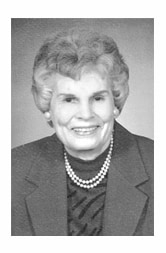Those of us who resided or grew up in Cardington before July, 1967, will remember the Beatty and Chase Building, the three-story structure that sat on the northeast corner of North Marion and East Main streets.
During my growing up years I remember it as being the home of a restaurant in the first part of the building and Koon’s Grocery in the second section.
In 1852, the lot just east of the building, was the town swimming hole because water stood in it year round. Although the rest of the village had been developed on the east and west, this area remained swamp-like.
When the town became incorporated, one of the first improvements was to grade and fill this area. Several frame buildings were then erected, the largest being on the corner which housed a dry goods store operated by C J. Shunk. The village newspaper, The Cardington Republican, functioned from the second floor. Other frame buildings east, housed two doctors a jewelry store and a tin shop.
These buildings were all extensively damaged by a fire in 1874. Construction on the three-story brick building replacing them was begun in 1876, the partnership erecting it included W. G. Beatty and R. F. Chase. The building was later transferred to J.C. Underwood, who owned it for many years.
Later, owners H. B. Fleming and Henry Poorman sold it to Gerald Anderson of Richwood. Earlier in 1967 Anderson transferred the title to Standard Oil Co.
The construction of the building’s third floor was financed by Cardington Lodge of Odd Fellows No #194 at a cost of $7,000 including furniture. The Lodge Hall was 42 x 72 feet and was claimed to be one of the finest in central Ohio.
On a personal note, my mother remembered attending events on that third floor when she was a youngster and her job was to take a peek out the window on the North Marion Street side of the building to see if the family’s horse was still tethered to the post below.
After the Lodge disbanded in 1944, local resident Bill Cowan organized a boy’s club and transformed the third floor into a recreational center with facilities for basketball, volleyball, gymnastics, ping pong and boxing, all for dues of 10 cents a month.
Brick for this building was believed to have been made in Cardington by Joseph Hickson, father of C.C. Hickson, of Mt Gilead, an English emigrant
who first lived in Delaware, moving to Cardington after the Civil War.
The Cardington Post Office occupied the corner room for about three decades prior to 1936. The Koon Grocery was located in the room to the right for about 40 years. J. C. Underwood operated a grocery in the room prior to 1920 and managed a dish store in the middle room. The corner rooms functioned as a restaurant with different owners for many years.
The building had been vacant for several months prior to its sale, the last occupant being a branch established by Campbell Auto Supply, Inc. during the oil boom.
The building’s top floor was removed by hand during the demolition in June, 1967. Heavy equipment demolished the remainder of the structure.
A service station was built on the site. After it closed, the building was was purchased and functioned as a convenience store for many years.
It has been vacant for the past two years.
OTHER NEWS JULY, 1967, CARDINGTON INDEPENDENT:
Three Morrow County students at Ohio University were spending the summer in Germany under the German Work Program sponsored by the university. They were Carolyn Heacock of Cardington, Michael McCombs of Mount Gilead and James Highsmith.
Mary Van Dorn, a 1957 Chester-Franklin graduate, was training in Salt Lake City, Utah, prior to leaving for Auckland, New Zealand where she was to serve in a mission there.






